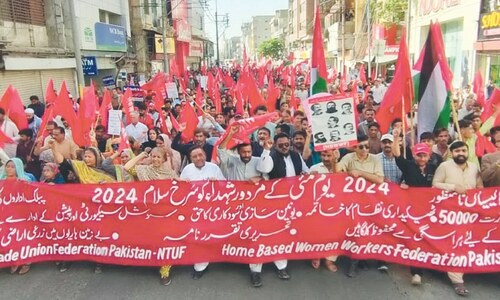KARACHI, Sept 2: An interesting perspective on how art journalists use the electronic media to have and convey a better understanding of the subject was given by Indian journalists Sahar Zaman and Dhiraj Singh at an event titled ‘Art and the airwaves’ at T2F on Saturday evening.
Ms Zaman, who is also a newscaster, briefly spoke about her foray into journalism. She specifically mentioned a television interview of the renowned British sculptor of Indian descent Anish Kapoor. She said that Mr Kapoor had not been to India in 15 years and it was art lovers’ earnest desire to have him display his works in India. She recalled how transporting his sculptures from one place to another had been a logistics nightmare because the pieces were very big.
Then Ms Zaman showed the footage of the sculptor’s interview which she conducted for CNN-IBN in 2010 as a freelancer.
During the interview, Mr Kapoor tells Ms Zaman that the sculptures on display (in Delhi and Mumbai) were from the work which he did from the 1980s to 2010. He says when he and those who work with him engage in a project it is like experimenting in a laboratory.
He briefly sheds light on his piece called ‘The orbit’ which was selected as the artwork for the London 2012 Olympics.
In response to a question, the distinguished sculptor argues that the work of all the artists can be seen in mythological terms. Artists create mythologies of various kinds. With regards to sculptures, he comments that they are all about space.
Once the interview was over, Ms Zaman reengaged with the audience and spoke on her curatorial projects. One of her projects was titled ‘Racism and reconciliation’, which she said was inspired by the acts of violence committed against young Indian men in Australia. She said a victim told her that the violence was not inspired by racial hatred but was sparked by petty crimes.
The exhibition featured two Indian and two Australian artists. She also told the people that one of her projects was on Sufism in Pakistan and for that Indian artists will visit different Sufi shrines in Pakistan.
The second speaker, Dhiraj Singh, Ms Zaman’s husband and also an artist. He currently heads programming at Lok Sabha Television and is also one of the participating artists in ‘Racism and reconciliation’.
With the help of slides, Mr Singh explained the inspiration behind the piece he made for the exhibition. He said he was born in Lucknow, in the area near a mental hospital where his mother worked. He observed that while physical injuries were visible, mental injuries were not. Afterwards, he began using X-rays for his artwork. Mr Singh also touched on his different art ventures, including the ones based on Greek mythological character Icarus, and Hindu goddesses Durga and Kaali and explained them to the audience as well showing visuals.
After his work, Singh talked about his job at Lok Sabha Television. He said that in 2006, some members of parliament felt that while the weaknesses of the MPs were being highlighted, their good performances were not being conveyed to the public.
This made Somnath Chatterjee come up with the idea of a channel which could broadcast Lok Sabha proceedings live and help people understand exactly how laws were made. He argued, with the help of footages, that the programme also helped create space for such activities in popular media discourse.
During the question and answer session, Singh, in a lighter vein, said that one of the differences that Lok Sabha TV was able to bring about was that India now had better-dressed politicians.
Replying to a question about the difference between India and Pakistan, he said that he could hardly notice any, save for the fact that the signboards in India were in Devnagri.














































Dear visitor, the comments section is undergoing an overhaul and will return soon.